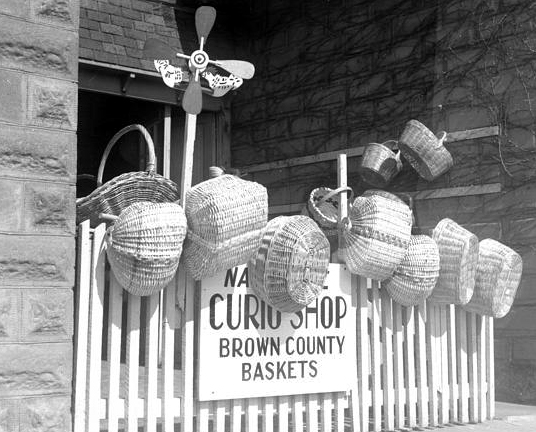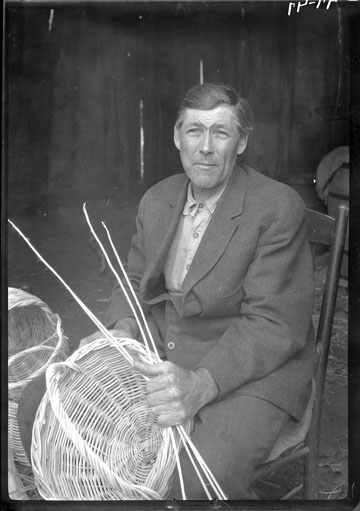Folk Crafts - Baskets
Baskets were utilitarian wares made in most communities throughout the state. While materials, designs and methods varied from maker to maker, baskets were a necessity for most Hoosiers, before the Industrial Revolution. Warren’s files have hand written notes about visits with basketmakers or family members and neighbors who remember basketmakers. His notes reflect his desire to record the names of these artists, their forms of baskets and specific methods of construction. The passage below, however, also demonstrates Warren’s attention to some of the social contexts in which baskets were made in Indiana.
Photo by Frank Hohenberger, courtesy of the Lilly Library, Indiana University
Oak-Rod Baskets and Their Makers Warren developed an interest in oak-rod basketmaking, which he believed to be a distinctively American craft. His research into this historic type overshadowed his interest in the other types of basketmaking traditions practiced in Indiana, which several of his students identified (i.e., split maple, willow, and split white-oak baskets). The oak-rod baskets had roots in German willow basket traditions, which had been practiced in Pennsylvania prior to being brought to Indiana in the 1800s. The origin and diffusion of oak-rod baskets were of special interest to Warren, perhaps due to his training in the historic-geographic method of folklore studies. On November 25, 1981, Warren interviewed John Bohall, the last of five brothers who made oak-rod baskets in Brown County. John had not made baskets in many years, but told Warren about the labor-intensive process and shared memories of his family and their craft. From this interview and his meticulous archival research, Warren produced an article that he submitted for publication in the Library of Congress’s Folklife Annual; however, it was never published. The article makes clear Warren’s interest in the craft’s history, geographic distribution, as well as the materials and tools of production. But like his article on Turpin Chairs, it also includes important information about the artisans. "John [Bohall] had four brothers, two older, George Jr. and Joseph, and two younger, Charles and Levi. All five sons helped their father as boys and learned the craft. They all continued to make baskets when they left home as long as they lived in Brown County. John married and moved into the small town of Belmont in eastern Brown County about midway between Nashville and Bloomington. There he lived in a log house. It must have been while he was living in Belmont that Frank Hohenberger photographed him in 1927. He reported that, as long as he lived in Belmont, he could sell as many baskets as he could make. Most of them he took to Nashville to sell, walking the eight miles each way. Since he often carried six bushel baskets, he said an observer could only see the baskets going down the road. John would be completely hidden. He would sell the baskets in Nashville to one of several people who would in turn retail them. Among the purchasers were a man named Bessire who had an orchard and Josh Bond, the owner of the Nashville funeral home. Sometimes John sold his baskets to Clarence Haines who lived atop Schooner Hill, a few miles closer to Belmont and hence not as long a walk for John. One winter, John says, Clarence Haines bought so many baskets his whole barn was full, but he sold them all in the spring. Each of these men who bought baskets from John may have sold then directly to tourists, though it is a bit hard to see how an undertaker could arrange many retail sales. Each of these men could also possibly have wholesaled the baskets to other buyers such as the Van Camp Hardware and Iron Company mentioned previously. John also on occasion walked into Bloomington, a distance of twelve miles, to sell baskets and remembers particularly selling them at a hardware store. A man who had owned a small grocery store on the south side of Bloomington in the 1920s and 30's told me several years ago that he used to buy baskets from an old man named Bohall, who walked in from Brown County with them. This must have been George Sr., John's father, for neither John nor his 'rothers could have been considered old men in the 20's or 30's." |

 Photo by Frank Hohenberger, courtesy
of the Lilly Library, IU
Photo by Frank Hohenberger, courtesy
of the Lilly Library, IU